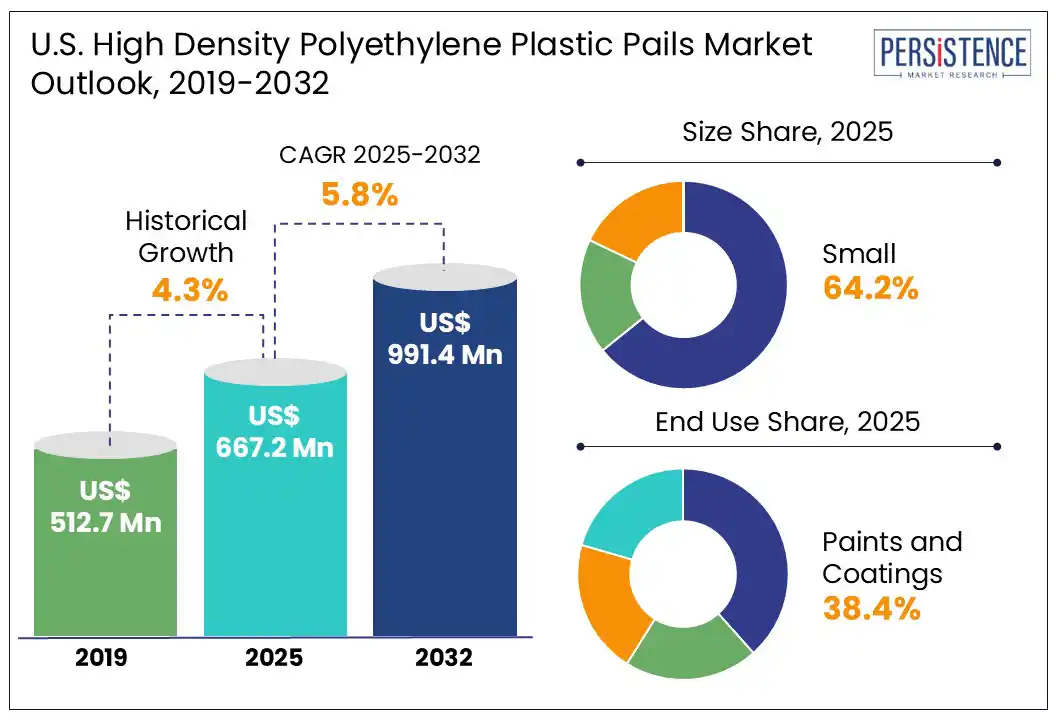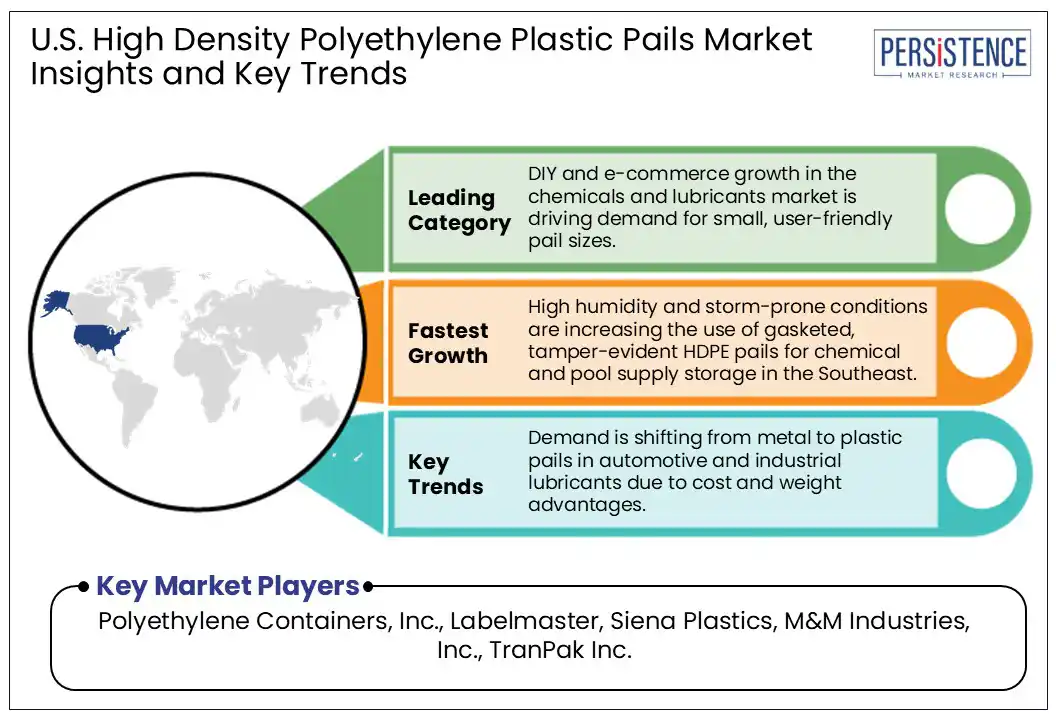ID: PMRREP35465| 145 Pages | 7 Jul 2025 | Format: PDF, Excel, PPT* | Chemicals and Materials

The U.S. high density polyethylene plastic pails market size is likely to be valued at US$ 667.2 Mn in 2025 and is estimated to reach US$ 991.4 Mn in 2032, growing at a CAGR of 5.8% during the forecast period 2025-2032.
Packaging is no longer just about containment; it is a performance element that affects product safety as well as transport efficiency. In this context, the U.S. high density polyethylene plastic pails market is gaining momentum across industries such as paints, foodservice, and chemicals. With surging demand for durability, chemical resistance, and sustainable formats, these pails are evolving into engineered solutions made for specific sectors. Leading companies are innovating in areas, including Post-Consumer Recycled (PCR) integration, in-mold labeling, and leak-proof lid technologies to gain a competitive edge.

Key Industry Highlights
|
Market Attribute |
Key Insights |
|
U.S. High Density Polyethylene Plastic Pails Market Size (2025E) |
US$ 667.2 Mn |
|
Market Value Forecast (2032F) |
US$ 991.4 Mn |
|
Projected Growth (CAGR 2025 to 2032) |
5.8% |
|
Historical Market Growth (CAGR 2019 to 2024) |
4.3% |
The excellent chemical resistance of HDPE is a primary driver of the U.S. high density polyethylene plastic pails market growth, finds Persistence Market Research. High density polyethylene’s (HDPE) ability to withstand a broad range of acids, bases, alcohols, and detergents without degrading makes it ideal for packaging industrial cleaning agents, agricultural inputs, and specialty chemicals. Agricultural chemical distributors across Iowa and Illinois have increased their use of HDPE pails for concentrated fertilizers, pesticides, and micronutrient blends.
The pails' non-reactive nature ensures product integrity during transport and storage, even when stored outdoors or in variable temperature conditions. The chemical manufacturing sector’s expansion is also amplifying this trend. This growth is accompanied by high demand for safe, standardized packaging that can handle batch variability and frequent handling. HDPE pails, which are inert to most reactive intermediates used in formulations such as adhesives, coatings, and sealants, meet these exact criteria.
High flammability and susceptibility to environmental stress cracking are two limitations that have been increasingly scrutinized in the U.S. market. While HDPE is widely favored for its chemical resistance and impact strength, it remains a combustible material. This poses a challenge in industries that require flame-retardant packaging, such as aerospace maintenance, certain industrial coatings, and hazardous material handling. HDPE’s vulnerability to environmental stress cracking has also led to premature failure in high-risk use cases.
The concern over stress cracking is amplified in regions with high UV exposure. Even UV-stabilized HDPE grades have shown degradation over prolonged exposure, leading to discoloration, brittleness, and eventual rupture. It is particularly evident in secondary storage or job-site containers left outdoors for extended periods. Hence, a few industrial users have begun specifying HDPE pails with novel additive packages or switching to rigid polypropylene or even steel pails for important chemicals.
The booming foodservice industry in the U.S. is predicted to create significant opportunities for HDPE pails in the foreseeable future. Chain restaurants, institutional kitchens, and food processors are increasingly using HDPE pails to store and transport bulk ingredients such as sauces, syrups, batters, oils, and ready-to-mix concentrates. HDPE’s FDA compliance, resistance to moisture, and non-leaching properties make it ideal for preserving product integrity in these applications.
Centralized food production models, commonly used by QSR and catering chains, are further fueling demand for HDPE pails that support bulk packaging with extended shelf life. In high-volume commissaries in Texas and Georgia, pails equipped with gasketed lids and in-mold labels are being adopted for pre-portioned meal kits and ready-to-eat formulations. These allow for easy stacking, portion control, and brand presentation. The rise of ghost kitchens and meal delivery services has also bolstered demand for lightweight yet durable pails that can withstand both cold storage and hot fill processes.
In terms of size, the market is trifurcated into small, medium, and large. Among these, small-sized pails are anticipated to account for nearly 64.2% of share in 2025 due to their operational efficiency, regulatory compliance, and compatibility with evolving supply chain formats. In foodservice, pharmaceuticals, and industrial maintenance sectors, these pails provide an ideal volume for controlled dispensing and single-shift usage. Hence, these help in reducing product wastage and contamination risk.
Large-sized HDPE plastic pails, primarily those in the 5-gallon and above range, are gaining momentum, owing to increasing consolidation of bulk handling practices across industrial and institutional sectors. In building materials, oilfield chemicals, and commercial cleaning industries, companies are shifting toward large pail sizes to reduce packaging waste, lower per-unit transportation costs, and simplify inventory management. Another factor pushing adoption is the operational efficiency they provide in closed-loop systems and automated dispensing environments.
Based on end use, the market is divided into paints and coatings, polymers, resins, and adhesives, and petroleum and lubricants. Out of these, the paints and coatings segment is poised to hold approximately 38.4% of the U.S. high density polyethylene plastic pails market share in 2025, owing to surging demand for leak-resistant and stackable packaging that can withstand solvents, pigment-heavy formulations, and frequent handling during distribution. The 5-gallon HDPE pail has become an industry standard for commercial paint applications. It is propelled by the requirements of contractors, who rely on bulk volumes for large-scale projects while demanding packaging that is both resealable and compatible with tinting and agitation systems.
Petroleum and lubricants, on the other hand, are expected to witness a steady growth rate through 2032 amid the sector’s specific requirements for chemical compatibility, leak-proof storage, and robust handling during transportation and distribution. Lubricant manufacturers and oil distributors favor HDPE pails due to their superior resistance to hydrocarbon-based contents and their ability to maintain structural integrity under varying temperatures. The automotive aftermarket is a key driver of this packaging format. This is because small- to mid-size repair shops frequently purchase engine oils, greases, and transmission fluids in pails to balance volume with manageability.

In the Southwest, demand for HDPE plastic pails is rising from the construction, agriculture, and chemicals sectors, which are considered significant consumers of bulk packaging. Texas and Arizona have seen consistent growth in industrial activity, mainly in oilfield chemicals, concrete additives, and crop protection segments. These rely heavily on durable and stackable HDPE pails for transport and storage. The construction boom in Texas, augmented by infrastructure and housing developments, has pushed the consumption of HDPE pails for materials, including adhesives, sealants, and coatings.
Local manufacturers and distributors are increasingly adapting to harsh climate conditions by providing UV-stabilized HDPE pails that prevent material degradation during outdoor storage. There is also a surging preference for tight-head pails in this zone, especially among chemical processors located near Houston and the Gulf Coast. This is because they often prioritize leak-proof packaging for volatile materials during transport. The proximity to the U.S.-Mexico border further plays a key role in shaping supply chain dynamics. Cross-border trade in agricultural inputs and paints has led to high turnover of pails between maquiladoras in Northern Mexico and U.S. fillers.
In the Southeast, the market is shaped by high demand from the booming food processing, industrial cleaning, and automotive lubricant sectors. Georgia, Florida, and North Carolina serve as hubs for manufacturing and logistics, pushing a steady demand for HDPE pails, particularly in 3.5- to 5-gallon sizes. The Savannah Port expansion and rising intermodal freight activity in Atlanta have supported high regional throughput of bulk-packaged goods. These include citrus-based cleaning agents, sauces, and industrial adhesives that are shipped in HDPE containers due to their chemical resistance and stacking stability.
In Florida, HDPE pails with gasketed lids and tamper-evident features have seen increased usage. This is due to the state’s hurricane-prone conditions that require rugged packaging solutions for emergency supplies and relief kits. The state’s surging marine and pool chemical industries have also contributed to demand for UN-rated HDPE pails with vented lids that prevent pressure buildup in high-humidity environments. Labor shortages and rising resin costs in the Southeast have further prompted several manufacturers to automate pail production lines and implement multi-cavity molds to maximize throughput.
In the Midwest, the market is primarily accelerated by the presence of well-established agricultural chemicals, industrial coatings, and processed foods sectors. Packaging hubs in the zone are concentrated around Illinois, Ohio, and Minnesota. Its strong manufacturing backbone, mainly in automotive and heavy machinery, has led to high-volume usage of HDPE pails for lubricants, greases, and metal treatment chemicals. The zone also shows strong integration between HDPE pail manufacturers and agribusiness suppliers.
Companies distributing crop protection chemicals and micronutrients across Iowa, Nebraska, and Indiana use reinforced HDPE pails with vented screw caps to meet safety and reusability demands. The seasonal nature of agriculture in the Midwest causes spikes in pail demand between March and July. This prompts regional manufacturers to maintain agile production schedules and warehouse inventory during the off-season to fulfill short-cycle bulk orders. The vertical integration of resin supply and packaging manufacturing is considered a key trend in the zone.
The U.S. high density polyethylene plastic pails market houses various established packaging giants, regional players, and niche manufacturers. Leading players are focusing on strengthening their presence in both industrial and food-grade applications. They often benefit from economies of scale, in-house recycling capabilities, and extensive distribution networks, which enable them to provide competitively priced, customizable HDPE pail solutions. A few companies are increasingly leveraging PCR HDPE content and closed-loop recycling programs to appeal to eco-conscious clients. They are also investing in lightweighting technologies and hybrid molding techniques to reduce material usage without compromising durability.
The market is projected to reach US$ 667.2 Mn in 2025.
Increasing number of food processing hubs and rising construction activity are the key market drivers.
The market is poised to witness a CAGR of 5.8% from 2025 to 2032.
Emergence of leak-proof pails and the introduction of closed-loop recycling systems are the key market opportunities.
Polyethylene Containers, Inc., Labelmaster, and Siena Plastics are a few key market players.
|
Report Attribute |
Details |
|
Historical Data/Actuals |
2019 - 2024 |
|
Forecast Period |
2025 - 2032 |
|
Market Analysis Units |
Value: US$ Bn/Mn, Volume: As Applicable |
|
Geographical Coverage |
|
|
Segmental Coverage |
|
|
Competitive Analysis |
|
|
Report Highlights |
|
|
Customization and Pricing |
Available upon request |
By Size
By Handle Type
By End Use
By Zone
Delivery Timelines
For more information on this report and its delivery timelines please get in touch with our sales team.
About Author